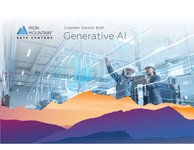Whilst most of us have heard about generative AI, a term that’s been around since the 1960s, it has only recently become a part of our day-to-day lives and the mainstream consciousness. It can open many doors and provide countless benefits, not only to our personal lives but also to businesses.
Findings from IDC, predict that by 2026, 85 percent of the connected population in EMEA will actively benefit from generative AI in their daily lives. However, to get the necessary impact out of their investment, businesses need to ensure a thorough implementation of generative AI, where it gets adopted in the right way to ensure a positive experience for all.
Generative AI can provide endless opportunities and benefits across a range of operations and activities. By implementing it, organizations can automate faster and streamline process discovery and development by enabling users to write prompts to create processes, automation, and other components. By making data analysis easier and more accessible, generative AI can help facilitate improved decision-making. By seamlessly integrating more complex and nuanced use cases into existing processes, we can reduce the complexity of automation in a way that causes minimal disruption or impact on the quality.
But behind the success, there must always be robust data governance, security, and accountability. Any business adopting the technology for whatever process needs to ensure that trust and transparency come first and are ‘by design’, not just an afterthought. This is where the fusion of intelligent automation (IA) and generative AI makes for a winning combination.
Responsible automation
Generative AI needs to be accountable and auditable. It needs to be instructed and learn what information it can retrieve. Combining it with IA serves as the linchpin of effective data governance, enhancing the accuracy, security, and accountability of data throughout its lifecycle.
Put simply, by wrapping generative AI with IA, businesses have greater control of data and automated workflows, managing how it is processed, secured – from unauthorized changes – and stored. It is this ‘process wrapper’ concept that will allow organizations to deploy generative AI effectively and responsibly.
The adoption and transparency of generative AI is imperative, as innovation continues to grow at pace. The past 12 months have seen significant innovations in language learning models (LLMs) and generative AI to simplify automation that tackles complex and hard-to-automate processes. According to IDC, this includes large enterprises relying on AI-infused processes to enhance asset efficiency, streamline supply chains, and improve customer satisfaction.
Five years ago, AI tools and models were fairly limited and had narrow applications, but now with off-the-shelf learning models and applications requiring low skills, the only barrier to entry limiting generative AI adoption is data quality.
With 80 percent of tech leaders planning to adopt generative AI within three years (Gartner), organizations across all sectors are chomping at the bit to utilize these exciting new technologies within their business processes. Maintaining data security and compliance is imperative.
Preparing for the future
Whether you’re a manufacturing powerhouse or a global financial institution, summarizing vast quantities of unstructured data is a challenge for the C-suite and revenue teams alike. Forrester’s AI Pulse Survey highlights how – as generative AI adds pressure on systems – measurement becomes unpredictable, complicating insight delivery.
Managing security, privacy, and consent adds another layer of complexity. Machine learning’s random nature demands live data sets for measurement and monitoring, lacking a standard linking generative AI models to source data, increasing uncertainty and risk – the single biggest barrier to adoption of generative AI by B2B enterprises.
Before implementing any sort of new automation technology, organizations must establish use cases unique to their business and undertake risk management assessments to avoid potential noncompliance, data breaches, and other serious issues.
With the right guardrails in place via a process wrapper like IA to control data input, output, and training models, generative AI can transform how a business automates its processes. By combining it with IA as the process wrapper, organizations can ensure the security of their data management and transparency.
Vendors are offering a surplus of options, making it important for customers to differentiate between hype and actual business value. The boundaries of cloud, data, AI, and automation software will continue to be pushed, leading to unique applications that overlap. Furthermore, the combination of IA and generative AI can effectively facilitate data governance, enhancing the accuracy, security, and accountability of data throughout its lifecycle, allowing business leaders to confidently leverage generative AI to its fullest potential to drive their business forward.
By investing in digital technologies and a digital workforce, organizations can safeguard their data management and make informed decisions. They can also maintain transparency and trust in their operations by using IA as the process wrapper.




